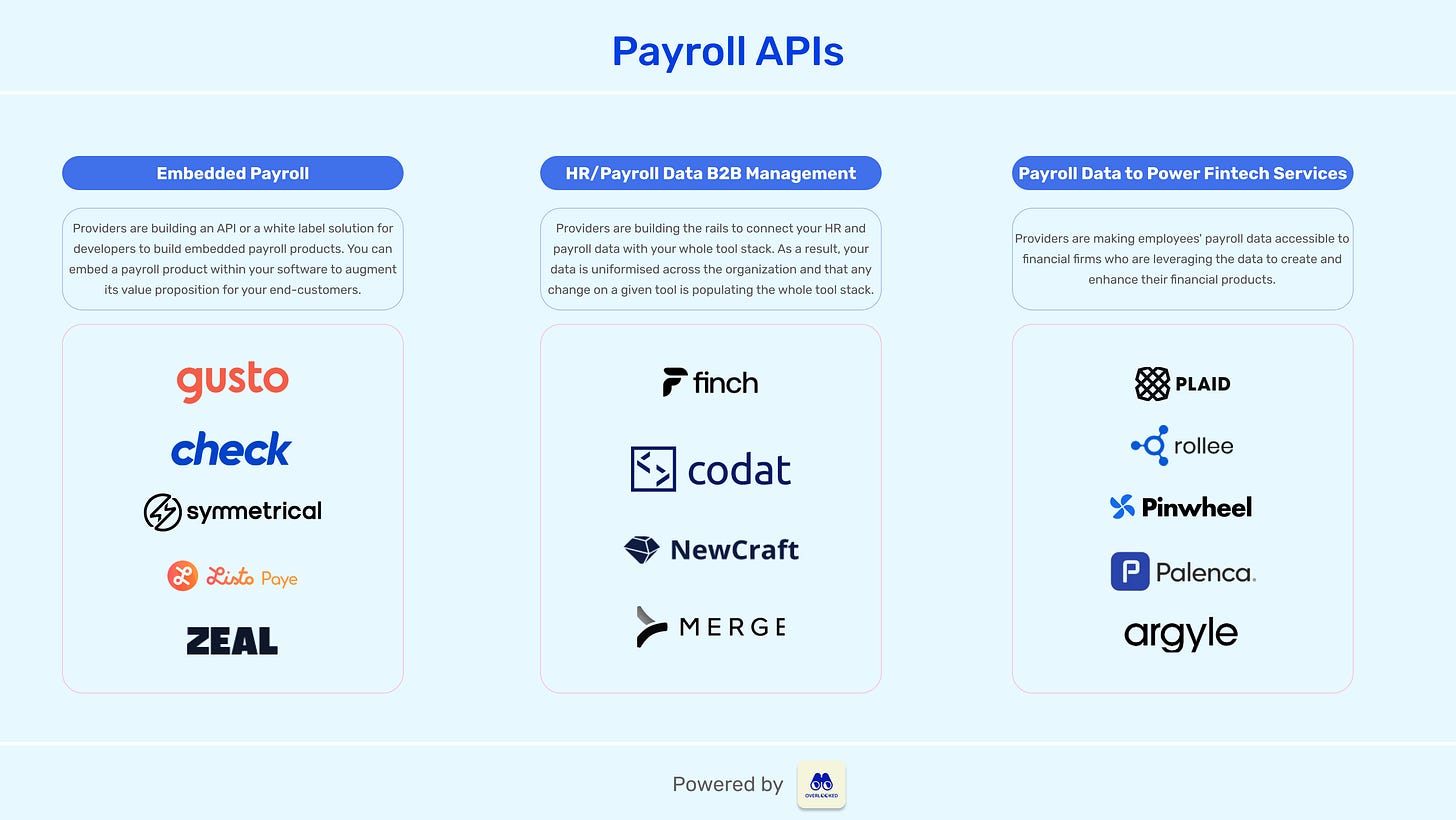💸 Unpacking Payroll APIs
Overlooked #82
Hi, it’s Alexandre from Eurazeo (ex. Idinvest). I’m investing in seed & series A consumer and consumer enablers startups all over Europe. Overlooked is a weekly newsletter about venture capital and underrated consumer trends. Today, I’m unpacking what it means to into build a payroll API.
Payroll API is a hot topic. Both established tech companies (Gusto, Plaid) and new startups are talking about building a payroll API. But they don't all mean the same thing. In this post, I'll dig into the value proposition of these players and try to cast some light on this topic.
We can distinguish 3 main value propositions when we talk about payroll APIs:
Embedded payroll solutions,
HR/Payroll data management solutions,
Access to payroll data to power financial services.
If you are building a payroll API, I’d love to meet you. You can ping me at adewez@eurazeo.com.
1. Embedded payroll solutions (Check, Zeal)
Providers are building an API or a white label solution for developers to embed payroll into their products. You don't have to rebuild a payroll engine from scratch. You can embed a payroll product within your software to augment its value proposition for your end-customers - hence increasing stickiness and ACV and reducing churn.
For instance, Check is working with Service Titan which is a vertical SaaS for home services (e.g. plumbers, electricians, etc.). Service Titan is building a business-in-a-box SaaS for its customers and it makes perfect sense for them to add the payroll brick to its suite.
In Jun. 2021, Gusto launched its own payroll API called Embedded Payroll which is an API or a white label platform to let third party embed payroll into their application. Gusto is already embedding payroll for many customers including Squire (vertical SaaS for barbershops), Vagaro (SaaS enabled marketplace for the beauty industry) and Xendoo (tax services and SaaS offering online bookkeeping).
2. HR/Payroll data management solutions (Finch, Newcraft)
Providers are building the rails to connect your HR and payroll data with your whole tool stack. As a result, your data is uniformised across the organization and any change on a given tool will be populated in the whole tool stack.
For instance, Finch has a Segment-like pitch in which your payroll and HR data is synchronised across the whole organization.
3. Access to payroll data to power financial services (Pinwheel, Argyle)
Providers are making employees' payroll data accessible to financial firms who are leveraging the data to create and enhance their financial products.
For instance, Pinwheel is going to market with financial services companies around 3 key use cases:
Direct deposit switching: as a bank, you become the primary account of your customer by redirecting his salary to the account he has with you.
Paycheck linked lending: like revenue based financing, you index a loan to the salary earned by your customer and you are paid back directly from its salary.
Income & employment data: instead of relying on a credit bureau to lend money to individuals, you build a credit scoring model based on their income and employment data which enables you to serve customers that you were not able to serve before and to have a more granular view of its credit profile.
Plaid also released its own payroll API focused on leveraging payroll data to power new financial services with two products similar to what Pinwheel is offering: deposit switching and income verification.
Bibliography
Payroll Data Whitepaper - Plaid, Nov. 2020
Making sense of Payroll APIs - Check, May 2021
The Promise of Payroll APIs - a16z, Oct. 2020
Get Paid However You Want- Base10, Sep. 2020
Thanks to Julia for the feedback! 🦒 Thanks for reading! See you next week for another issue! 👋


